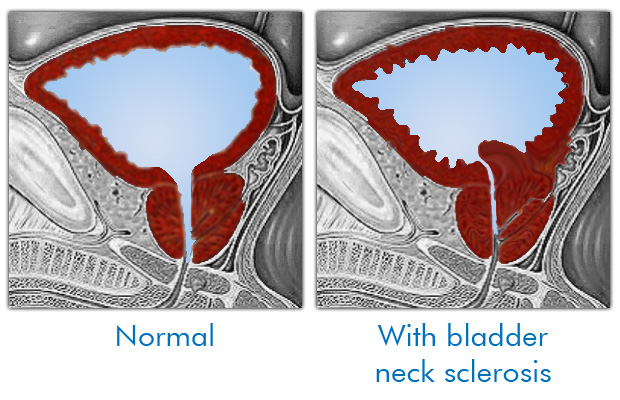Urethral prostate Reflux
When discussing the peripheral acini we mentioned the urethral-prostate reflux. This is the abnormal passage of urine from the urethra into the prostate. Like all fluids, urine flows where pressure is lowest and finds it “convenient” to leave the urethra and flow into the prostate only under certain pathological conditions. These include:
 increased endourethral pressure due to urethral narrowing below the prostate, the most common causes being nerve-based periurethral and sphinteric musculature rigidity, congenital stenosis or stenotic outcome of previous episodes of urethritis,particularly if due to gonorrhea;
increased endourethral pressure due to urethral narrowing below the prostate, the most common causes being nerve-based periurethral and sphinteric musculature rigidity, congenital stenosis or stenotic outcome of previous episodes of urethritis,particularly if due to gonorrhea;
 abnormalities in the first urethral tract due to a narrow or poorly elastic bladder neck i.e. bladder neck sclerosis or dysectasia, which may be congenital or develop early in life.
abnormalities in the first urethral tract due to a narrow or poorly elastic bladder neck i.e. bladder neck sclerosis or dysectasia, which may be congenital or develop early in life.

In the first tract of the prostatic urethra urine flows hard against the posterior wall rather than parallel to the lateral walls. Unable to withstand this high pressure the posterior wall cedes and urine filters into the prostate (fig.5). Barbalias (1997) recently confirmed this hypothesis with his finding of high urethral closure pressure in patients with abacterial prostatitis who benefited from a course of alpha-blockers and antibiotics (Therapy). Kirby (1982) instilled water containing carbon microspheres into the bladders of 10 patients with chronic prostatitis and found the microspheres in 70% of prostate sections taken during transurethral resection (TURP) a few days later. In samples of prostatic secretion from patients with urethral-prostate reflux Persson and Ronquist (1996) found high urate and creatinine levels which not only facilitate stone formation but which also by their very presence induce an inflammatory response in prostate tissue. A transrectal ultrasound scan performed during the dynamic phase of micturition reveals signs of widespread prostatitis when urethral stenosis is present and shows prostatitis is localized in the periurethral area immediately below the bladder neck when bladder neck sclerosis is present (open picture ). Obviously, prostatitis cannot be cured until the anatomic abnormalities which are the underlying cause are rectified.
